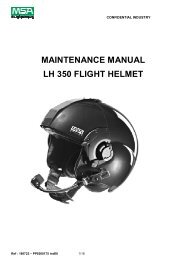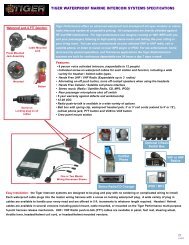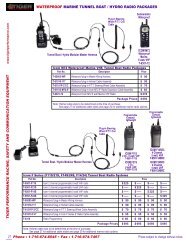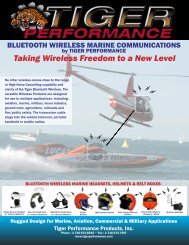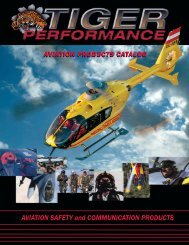or On Image for Downloadable MSA Gallet PDF Report - Tiger ...
or On Image for Downloadable MSA Gallet PDF Report - Tiger ...
or On Image for Downloadable MSA Gallet PDF Report - Tiger ...
You also want an ePaper? Increase the reach of your titles
YUMPU automatically turns print PDFs into web optimized ePapers that Google loves.
Construct<strong>or</strong> Tests File<br />
Aeronautic Helmet<br />
June 2001<br />
CONFIDENTIAL<br />
CONSTRUCTOR TESTS<br />
FILE<br />
HELICOPTER HELMET<br />
LH TYPE<br />
1/8
Construct<strong>or</strong> Tests File<br />
Aeronautic Helmet<br />
June 2001<br />
CONFIDENTIAL<br />
TEST RESULTS<br />
NOTICE :<br />
All tests have been carried out on LH 250 type helmet : those results are valid also f<strong>or</strong><br />
LH 050 and LH 150 type, as the shell of these type are the same of LH 250 type.<br />
SHOCK ABSORPTION TESTS<br />
These tests were carried out following the protocol proposed by MIL-DTL-<br />
87174/A (USAF) which requires a blow of 47,5 J without redoubling. The maximum<br />
acceptable acceleration is 400G with acceleration greater than 200G not exceeding 3<br />
ms and acceleration greater than 150G not exceeding 6 ms.<br />
The helmet meet <strong>or</strong> exceed all above requirements.<br />
Test rep<strong>or</strong>t n°3010643 (16 th of November 2001), from American lab<strong>or</strong>at<strong>or</strong>y ITS, can<br />
be shown on request.<br />
PERFORATION RESISTANCE TESTS<br />
These tests were carried out in acc<strong>or</strong>dance with the MIL-DTL-87174/A (USAF)<br />
standard with a requirement of 13,5 J and a validation condition which does not<br />
permit the point to come into contact with the dummy head.<br />
The helmet meets above requirements.<br />
Test rep<strong>or</strong>t n°3010643 (16 th of November 2001), from American lab<strong>or</strong>at<strong>or</strong>y ITS, can<br />
be shown on request.<br />
2/8
Construct<strong>or</strong> Tests File<br />
Aeronautic Helmet<br />
June 2001<br />
CONFIDENTIAL<br />
VALIDATION OF THE SCREENS QUALITIES<br />
The injected screen - validated with small outer clear and yellow screens and big<br />
inner green screen - meet <strong>or</strong> exceed the EN 1836 : 1997 standard f<strong>or</strong> :<br />
- Optical powers: spherical power (optical class 1), astigmatic power (optical<br />
class 1), and prismatic power difference (optical class 1),<br />
- Transmittance: filter categ<strong>or</strong>y 0 f<strong>or</strong> the clear and yellow, filter categ<strong>or</strong>y 3 f<strong>or</strong><br />
the green,<br />
- UV 400 protection: Transmittance (100 - 400nm) < 1 % f<strong>or</strong> all the colours, and<br />
IR protection: TSIR < 45 % f<strong>or</strong> the green and grey,<br />
- Requirements f<strong>or</strong> road use and driving,<br />
- Scattered light,<br />
- Enhanced robustness,<br />
- Resistance to radiation,<br />
- Ignition,<br />
The injected screen – validated with w<strong>or</strong>st configuration – meet <strong>or</strong> exceed the<br />
MIL-V-43511C standard f<strong>or</strong> optical qualities:<br />
- Vertical and h<strong>or</strong>izontal prismatic deviation,<br />
- Refractive power,<br />
- Luminous transmittance,<br />
- Optical dist<strong>or</strong>tion of critical areas,<br />
- Hase,<br />
- Ultraviolet transmittance,<br />
- Neutrality of the green and grey,<br />
- Chromaticity of the grey.<br />
The lab<strong>or</strong>at<strong>or</strong>y's rep<strong>or</strong>ts could be shown on request.<br />
3/8
Construct<strong>or</strong> Tests File<br />
Aeronautic Helmet<br />
June 2001<br />
CONFIDENTIAL<br />
ACOUSTIC INSULATION MEASUREMENT<br />
The measurements were carried out by the Ergonomics and Cognitive Sciences<br />
Department of the IMASSA (Institut de Médecine Aérospatiale du Service de Santé<br />
des Armées: Institute of Aerospatial Medicine of the F<strong>or</strong>ces' Health Service) in<br />
Brétigny sur Orge.<br />
The attenuation levels obtained with pink noise at 107 dBA are as follows:<br />
Frequency 50 63 80 100 125 160 200 250 315 400 500 630 800<br />
Attenuation 5,1 6,5 5,1 4 3,7 4,5 7 8,5 8,8 7,8 10,5 15 22,2<br />
Frequency 1000 1250 1600 2000 2500 3150 4000 5000 6300 8000 10000 12500<br />
Attenuation 25 29,9 34,1 41,9 46 49,1 50,9 53,9 57,3 61,1 57,5 55,6<br />
The test rep<strong>or</strong>t from IMASSA dated 1 st April 1997 can be shown on request.<br />
VALIDATION OF THE INTELLIGIBILITY OF THE ELECTRO-ACOUSTIC<br />
EQUIPMENT<br />
The measurements were carried out by the Ergonomics and Cognitive Sciences<br />
Department of the IMASSA (Institut de Médecine Aérospatiale du Service de Santé<br />
des Armées: Institute of Aerospatial Medicine of the F<strong>or</strong>ces' Health Service ) in<br />
Brétigny sur Orge.<br />
This test uses the Steeneken method of measuring intelligibility. It gives the STI<br />
index which defines the level of intelligibility of the equipment. It is considered that<br />
the minimum level of intelligibility c<strong>or</strong>responds to an STI index of 0.35: beyond this<br />
the<strong>or</strong>etical threshold intelligibility is deteri<strong>or</strong>ated to the extent that the user would<br />
have to ask confirmation from the person in contact.<br />
The test was carried out on 3 subjects subjected successively to silence and pink<br />
noise of 107 dBA intensity in a diffuse field. The helmet is fitted with a SILEC M-<br />
2000 equipment electro-acoustic unit.<br />
The helmet is validated: it gives a sufficient level of intelligibility.<br />
The test rep<strong>or</strong>t from IMASSA dated 1 st April 1997 can be shown on request.<br />
WEARING GLASSES<br />
4/8
Construct<strong>or</strong> Tests File<br />
Aeronautic Helmet<br />
June 2001<br />
CONFIDENTIAL<br />
In acc<strong>or</strong>dance with the EN-966 standard a check was made that wearing glasses<br />
was compatible with the operation of the helmet. The test was carried out with a large<br />
size helmet and a pair of average enveloping glasses: it was observed that the screens<br />
retain their <strong>or</strong>iginal kinematics.<br />
The helmet is thus validated f<strong>or</strong> wearing glasses, subject to glasses of reasonable<br />
dimensions being w<strong>or</strong>n.<br />
RESISTANCE TO PULLING OFF<br />
Insofar as the helmet has no post-cranial strap, it is appropriate to carry out a test<br />
of resistance to coming off so as to guarantee this option.<br />
The tests were carried out in acc<strong>or</strong>dance with the EN-966 standard. The helmet<br />
is subject to a traction f<strong>or</strong>ce applied to the back of the dome in the helmet's vertical<br />
median plane and directed at an inclination of 45° to the top and to the front. The<br />
conditions f<strong>or</strong> validation are that the helmet should not separate from the dummy head<br />
and that after the test the angle f<strong>or</strong>med by the reference line at the top of the helmet<br />
and by the reference plane of the dummy head should not exceed 30°.<br />
The helmet meets above requirements<br />
RETENTION SYSTEM RESISTANCE<br />
The tests were carried out in acc<strong>or</strong>dance with the EN-966 standard.<br />
The conditions f<strong>or</strong> validation are as follows. The dynamic stretching should not<br />
exceed 35 mm and the residual stretching should not be greater than 25 mm. After the<br />
test, the retention system should still enable the helmet to be removed from the<br />
dummy head by using opening device in the n<strong>or</strong>mal way.<br />
The retention system is validated in acc<strong>or</strong>dance with the EN-966 standard.<br />
BREAKAGE OF THE LADDER-LOCKS<br />
5/8
Construct<strong>or</strong> Tests File<br />
Aeronautic Helmet<br />
June 2001<br />
CONFIDENTIAL<br />
It is considered that breakage of the ladder-locks occurs at the point where the<br />
section encountered is weakest.<br />
Static traction tests were carried out on the retention system, where a check was<br />
made that the ladder-locks broke first at the two defined sections under a load of 170<br />
kg ( 1670N ).<br />
The breakage of the ladder-locks on the retention system is validated at 167 daN<br />
per ladder-lock.<br />
CLIMATIC TESTS<br />
These tests were carried out by the CEV (Centre d’Essais en Vol: Test Flight<br />
Centre in Brétigny).<br />
The cold tests ( -20°C ) and the hot tests ( +70°C ) validated the proper<br />
operation of the helmet. This test also provided assurance that the subjective<br />
impressions of comf<strong>or</strong>t, in extreme use, are satisfact<strong>or</strong>y.<br />
The DGA's test rep<strong>or</strong>t no. 19/CEV/SE/EQS/OV/1997 can be shown on request.<br />
FIRE RESISTANCE<br />
This test was carried out by the CEAT (Centre d’Essais Aéronautique de<br />
Toulouse : Aeronautics Test Center of Toulouse)<br />
The results show that the protection against fire and self-extinguishing<br />
properties aff<strong>or</strong>ded by the helmet is satisfact<strong>or</strong>y.<br />
The CEAT's test rep<strong>or</strong>t E 00/5825 Partiel 2 can be shown on request.<br />
TEST PROTOCOLS<br />
6/8
Construct<strong>or</strong> Tests File<br />
Aeronautic Helmet<br />
June 2001<br />
CONFIDENTIAL<br />
PERFORATION RESISTANCE<br />
Following protocol of MIL-DTL-87174/A (USAF) standard.<br />
SHOCK ABSORPTION<br />
Following protocol of MIL-DTL-87174/A (USAF) standard.<br />
ACOUSTIC INSULATION<br />
The method which was used is only valid f<strong>or</strong> studying the attenuation of a<br />
finished product, in this case the helmet, on a human subject.<br />
The measurement is made by difference of rec<strong>or</strong>ding between an uncovered<br />
dummy head and a dummy head wearing the helmet. The dummy head is fitted with<br />
integrated microphones placed by the ears; these microphones measure the acoustic<br />
level. The dummy head is placed h<strong>or</strong>izontally in a diffuse field subjected to pink noise<br />
of an amplitude of 107 dBA.<br />
The measurement covers a frequency band ranging from 50 Hz to 12500 Hz.<br />
RESISTANCE TO PULLING OFF<br />
Following protocol of EN-966 standard.<br />
RETENTION SYSTEM RESISTANCE<br />
Following protocol of EN-966 standard.<br />
ALTITUDE DECOMPRESSION TEST<br />
This test consists of a rapid climb to 40000 ft followed by levelling off at this<br />
altitude and descending at 20 m s . F<strong>or</strong> this test the subject is equipped with an Ulmer<br />
82 GK breathing mask. The helmet is fitted with a radio telephone providing<br />
monit<strong>or</strong>ing of the subject. The regulat<strong>or</strong> is of the IN 437 type.<br />
A check is made that no anomaly appears. A check is also made on the level of<br />
protection against hypoxia on descending and lastly if the Valsalva manoeuvre can be<br />
carried out.<br />
CENTRIFUGE TEST<br />
7/8
Construct<strong>or</strong> Tests File<br />
Aeronautic Helmet<br />
June 2001<br />
CONFIDENTIAL<br />
Three subjects take part in this assessment. They are equipped with ARZ 830<br />
anti-g trousers, a GP 2000 pressure suit and a Ulmer 82-type mask. Each subject<br />
carries out two runs: the first on a GOR profile (Gradual <strong>On</strong>set Rate) with an<br />
acceleration increase rate of 0.1G s and a 9G z<br />
stop and the second on a ROR profile<br />
(Rapid <strong>On</strong>set Rate) with an acceleration increase rate of 0.6 G s and levelling off of<br />
15 to 20 seconds at 5.7 and 9G z<br />
. <strong>On</strong> the second run ventilat<strong>or</strong>y superpressure is given<br />
from 4 G with a maximum value of 90 hPa at 90G z<br />
.<br />
After the test each subject's impressions are obtained.<br />
FIRE RESISTANCE<br />
The helmet is fitted to a dummy's head fitted with thermocouples. This head is<br />
fixed on a h<strong>or</strong>izontal supp<strong>or</strong>t firmly attached to a gantry allowing the assembly to pass<br />
over a kerosene fire. The period spent in the fire lasts f<strong>or</strong> 8 seconds during which the<br />
temperatures on the surface of the dummy are continuously rec<strong>or</strong>ded. At the end of<br />
exposure, observing the equipment and the state of the dummy provide an assessment<br />
of the protection given by the equipment.<br />
EJECTION RAMP TEST<br />
A dummy with an articulated neck is fitted with the helmet, transparent vis<strong>or</strong><br />
lowered and locked like a pilot in flight, and tied onto an MK 10 eject<strong>or</strong> seat. The seat<br />
is fitted onto a ramp inclined at 30°. The ejection <strong>or</strong>der is then given in the same<br />
conditions as in flight (16G z<br />
), then quickly braked. The sequence is filmed using a<br />
TV camera and a rapid-shot camera<br />
CLIMATIC TESTS<br />
A cold test is carried out at a temperature of -20°C f<strong>or</strong> 15 minutes. Another is<br />
carried out under heat at a temperature of +35°C and 25 % relative humidity.<br />
Temperature measurements are made only on the hot test. The subject is equipped<br />
with a flying suit, polar equipment during the cold trial, and a helmet fitted with an<br />
Ulmer 82-type mask.<br />
8/8








